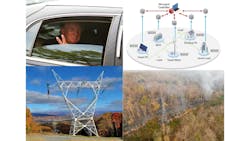Power at the Crossroads: Wildfires, Storms, and the Future of Energy Resilience
We start working on our February print issue at the beginning of the year, so in magazine editors’ minds, the month of January already “feels” over before we even reach Jan. 15. It certainly helps our winter blues when we are always a few weeks ahead in our heads. Of course, I drive my family crazy when I have no idea what month we are actually in and tend to already be thinking about the next big thing we have to plan for.
January and February are also those months when we tend to be covering winter storm warnings and outages, and what utilities are doing to monitor icing lines and ensure capacity for high demand. At the time of writing this year, however, we are watching the devastation of wildfires in the Los Angeles area. LADWP and SCE have been directly affected, and SDG&E and PG&E have been doing public safety power shutoffs to avoid high winds damaging equipment and potentially sparking a fire due to such dry conditions.
The Eaton Fire led to extensive power outages for SCE; about 414,000 SCE customers were without power on Jan. 7, with an additional 454,000 under a PSPS watch at that time. LADWP also had outages affecting more than 28,000 customers. PG&E stepped in to help; providing mutual assistance: PG&E Safety and Infrastructure Protection Teams cleared brush and treated poles with retardant on the ground. The 25 SIPT engines, comprised of 2-person crews, assisted LADWP with preventing or limiting damage to infrastructure. The crews went from pole to pole to clear vegetation and treat the areas as high as they could.
And as par for the course, lawsuits are being filed, the consumer media is writing click-bait, anti-utility headlines all before investigations are completed. Every time this happens, electric utilities are the center of the story as they work to restore power and rebuild infrastructure and file Electric Safety Incident Reports where possible.
We at T&D World are heartbroken for the victims, and our hearts are with the utilities and how they will be affected by the damage and potential fault. We know utilities have come a long way in wildfire mitigation, and there is still more work to do. We will be once again putting together a special Wildfire section in our May issue, so feel free to contact us to tell your utility’s story — what you have done in the wildfire mitigation area, or even what is in your plans.
AI, Transmission Construction and Policy Updates
Last month, I included the growth of AI in utility operations as one of the top three predictions for trends this year. We will cover this topic quite a bit in our Charging Ahead department written by Technical Editor Gene Wolf. This month, he explains what AI-powered microgrids are; providing an evaluation of how they work for our industry. I always enjoy Gene’s take on AI; he is a realist and not a fearmonger and is the perfect engineer to share with us how new technologies can help utilities. I used to think AI was scary; Gene had helped dispel those concerns. Great benefits can be had from AI for power delivery systems, and good luck waiting until AI is non-controversial to seriously consider it, as Gene says.
I am proud of our cover story, as it is core to what T&D World is; it’s a transmission construction feature. We see transmission construction stories regularly appear in our top five to 10 most-visited articles in any given time frame. In this story, Dominion shares the Mt. Storm to Valley line rebuild, which stretched 64.5 miles through some seriously tough, mountainous terrain. The team had to tackle major challenges, like tough access roads, unpredictable weather, and strict environmental and regulatory rules. To get the job done, they built new roads, installed temporary bridges, and even designed custom steel towers to handle the rough conditions. They also went the extra mile to protect local wildlife, like bats and trout, while keeping everything up to the U.S. Forest Service’s high standards. Despite all these hurdles, the project wrapped up on time in December 2023, giving the area a more reliable and durable transmission system.
Policy is another big story for our industry (and every industry) this year with the swearing in of a newish presidential administration. Managing Editor Jeff Postelwait takes frank look at the potential regulatory changes that may come with a Trump 2.0 administration. Trump’s proposed energy policy for his second term focuses on increasing domestic energy production, reducing regulations, and prioritizing affordability and reliability. Key initiatives include creating a National Energy Council, led by Doug Burgum, to streamline energy policy and encourage private investment. Trump’s energy team, including Chris Wright at the Department of Energy and Lee Zeldin at the EPA, emphasizes fossil fuel development, baseload power generation, and skepticism toward renewable energy mandates. It remains to be seen whether he will reverse many of Biden’s clean energy policies, possibly shifting focus toward resource extraction, carbon capture technology, and deregulation to achieve “energy dominance” and drive economic growth.
About the Author
Nikki Chandler
Group Editorial Director, Energy
Nikki is Group Editorial Director of the Endeavor Business Media Energy group that includes T&D World, EnergyTech and Microgrid Knowledge media brands. She has 29 years of experience as an award-winning business-to-business editor, with 24 years of it covering the electric utility industry. She started out as an editorial intern with T&D World while finishing her degree, then joined Mobile Radio Technology and RF Design magazines. She returned to T&D World as an online editor in 2002. She has contributed to several publications over the past 25 years, including Waste Age, Wireless Review, Power Electronics Technology, and Arkansas Times. She graduated Phi Beta Kappa with a B.S. in journalism from the University of Kansas.

